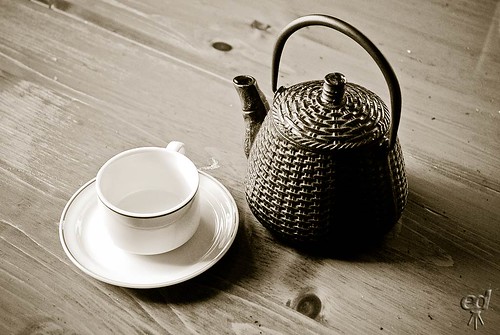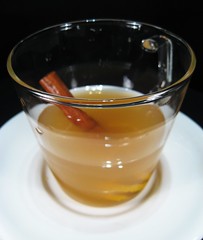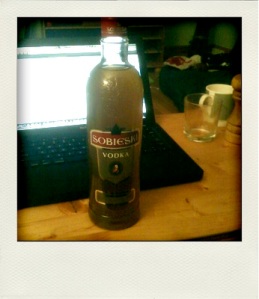Forty Nine: L'Étranger Cocktail
Let's talk a little about context. After all, it's often said that nothing happens in a vacuum - though that's patently untrue given our little marble of evolved consciousness does circuits in one - and so much of the difficulty of creating recipes is creating those contexts in which your chosen ingredients can shine. I've been exploring the idea of seasonally appropriate flavours over recent weeks which, naturally, got me onto thinking about seasonally inappropriate flavours. Things that work in the context of sunny summer afternoons often don't on rainy winter evenings. Beyond that, certain types of ingredient have fallen into specific contexts over time. If I'd thought about it at the start of this project, the notion of using a vermouth in a refreshing citrusy cocktail would have seemed counterintuitive, given my own attitudes towards fortified wines back in the day. Context - or more accurately, the previous contexts in which an ingredient or technique are found - is a useful guide, but it shouldn't be taken as a stonecrafted edict.
And so we come to orgeat. No, this is not supposed to be a non sequitur.

Orgeat is beloved by many, but is rarely used outside of tiki drinks and more rarely still with spirits other than rum. If it appears in a recipe, you'd get incredibly long odds on the drink not falling into Embury's Sour Type classification. This may be as much because including an opaque sweetener in an Aromatic Type drink runs against the standardized aesthetic of a brilliantly clear beverage as it is because orgeat combines so very well with citrus and rum. However, once I'd realized that orgeat is hardly used outside of the tiki/rum/sour context, the obvious thing was to try it in an entirely different one.
This is how we end up talking about hot drinks.

Tea Cup Pot by Eduardo Mueses on Flickr.
There are exceptions - the Irish Coffee being the most notable - but hot alcoholic drinks are rare. It's worth remembering that they existed before iced cocktails, given the difficulty of obtaining a consistent supply ice in the era before refrigeration. One of the most popular concoctions of the North American colonists was flip, which was "mixed with a device called a loggerhead..."
"- a narrow piece of iron about three feet long with a slightly bulbous head the size of a small onion. It was originally created for heating tar or pitch, with the bulb buried in the glowing coals until it blazed red-hot, then quickly withdrawn and plunged into the pitch to make it pliable. The instrument served a similar heating function when plunged red-hot into a beer-rum-and-molasses concoctions. The whole mess would foam and hiss and send up a mighty head." Wayne Curtis, And a Bottle of Rum, p. 83
As I'm lacking in both an open fire and a loggerhead, I'd have to go for less dramatic means of heating my drink. In time, I'd also opt to steer clear of coffee and dairy. Fernet Branca and cloves were chosen as complementary flavours on top of a whisky base, the Glenrothes Select Reserve in this case. As for the orgeat, it really does work in this drink. Sometimes, taking things out of context is the only way to go.

L'Étranger Cocktail
50ml The Glenrothes Select Reserve
15ml orgeat
15ml Fernet Branca
5 cracked cloves
50ml hot water
Combine all ingredients in a mixing glass or suitable heat-proof container. Fine-strain into a small tea-cup or rocks glass (if you're going for a glass, make sure to heat it first so it doesn't crack). Garnish with a twist of lemon zest and a cinnamon stick.



 Krupnik
Krupnik I opted for the above recipe, more or less verbatim. The thing I changed was the honey. In the end, I used three different varieties: acacia (light, floral), manuka (heavy, medicinal) and blossom (somewhere inbetween). The acacia honey keeps its liquidity naturally, so I picked a 'runny' pack of the blossom, leaving the heavier, more solid manuka to provide some bass. The other key ingredient was, of course, the vodka. I already had a bottle of Sobieski Vodka on a shelf thanks to an old colleague, and not being a prolific vodka drinker, it wasn't doing much.
I opted for the above recipe, more or less verbatim. The thing I changed was the honey. In the end, I used three different varieties: acacia (light, floral), manuka (heavy, medicinal) and blossom (somewhere inbetween). The acacia honey keeps its liquidity naturally, so I picked a 'runny' pack of the blossom, leaving the heavier, more solid manuka to provide some bass. The other key ingredient was, of course, the vodka. I already had a bottle of Sobieski Vodka on a shelf thanks to an old colleague, and not being a prolific vodka drinker, it wasn't doing much. There are things I'm disappointed in: the colour, for one. The blossom honey is pretty dark and combined with the manuka, it makes the whole thing look kinda murky. Still, it shows a lovely amber glow when you hold it up to the light and if I had any skills in clarifying liquids, I'm sure I could clean it up further. I'm also pretty sure that I put too much honey in the mix; the final liqueur is maybe just a shade too sweet for me.
There are things I'm disappointed in: the colour, for one. The blossom honey is pretty dark and combined with the manuka, it makes the whole thing look kinda murky. Still, it shows a lovely amber glow when you hold it up to the light and if I had any skills in clarifying liquids, I'm sure I could clean it up further. I'm also pretty sure that I put too much honey in the mix; the final liqueur is maybe just a shade too sweet for me.